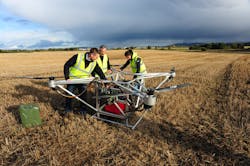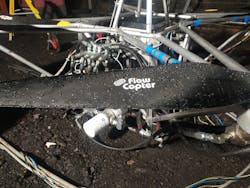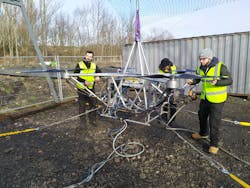Digital Displacement Hydraulic Technology Lifts Off
Among the dizzying number of drone videos shared on YouTube, there are few that we’re willing to share. But when the R&D engineers at Flowcopter Ltd. reached out to glean interest in doing a story on their hydraulic hybrid multicopter, something was different.
The founders of Flowcopter were involved in developing the underlying digital displacement hydraulic pump (DDP) technology at an Edinburgh company called Artemis Intelligent Power (AIP). Danfoss acquired the company in 2021 and has been using DDP technology to disrupt the hydraulics market. The technology is touted for delivering greater efficiency and increased productivity, particularly in off-highway applications.
The Flowcopter team, led by a group of 2015 MacRobert award winners (the UK’s most prestigious prize for engineering innovation), set out to commercialize DDP technology for the aerospace industry. Their heavy-lift drone is intended to be a workhorse platform, targeting applications traditionally requiring manned helicopters, said Calum Arnott, one of Flowcopter’s R&D engineers. This includes precision agriculture, reforestation, offshore logistics, search and rescue, rural delivery and law enforcement.
Flowcopter’s engineers noted that DDP technology can be driven by either a liquid fuel IC engine or a more conventional battery-electric combination. For the multicopter, they envision using an IC engine for long-endurance flight, with a backup electric motor to cover short distance flight.
“At its core, [DDP] is a very efficient, multi-outlet, digitally controlled pump with fast control response,” explained Arnott. “This enables us to independently control the flow rate to each of the four hydraulic motors driving our propellers. The DDP transmission provides control bandwidth necessary for our multicopter, in which fast and precise control of each propeller is essential for stable flight.”
We had a few more questions for the engineers: Was battery-electric power considered? What are the advantages of using DDP? What is the multicopter’s range?
Their responses, which follow below, have been condensed and edited for clarity.
What advantage does DDP have over conventional hydraulics and pure electric transmission?
Whilst much of the recent multicopter development has been focused on battery-electric power, hydraulics are not new to the aviation industry. Every day, seven million people fly on aeroplanes, which use hydraulic technology for control surfaces, landing gear, brakes, flaps and more. Hydraulics are chosen for their high power density/specific power and reliability. For example, Eaton’s hydraulic engine-driven pumps are used in Airbus A330, A340 and A380 platforms with an average reliability exceeding 50,000 hours MTBF.
The DDP provides a highly efficient method of power transmission to our hydraulic motors. Our Hydro Leduc motors have an extremely high specific power output. Each one is capable of producing 96kW continuous output power whilst weighing only 5.5kg. Hydraulic motors are also inherently robust and capable of withstanding tough environmental use cases—they are most often found powering outdoor all-weather industrial equipment such as excavators and salt-spray spreaders.
By taking hydraulically powered heavy-lift multicopters to the sky, Flowcopter can target applications that have traditionally required helicopters whilst reducing O&M cost and improving personnel safety through autonomous, unmanned flight.
How were you able to improve the range to six hours?
We are able to have long-range flight by making use of a liquid fueled type-certified aircraft engine. This allows us to run on liquid fuel with significantly greater energy density/specific energy than batteries. Our goal is to run on net zero carbon synthetic fuel. This involves extracting hydrogen from water by using energy generated from renewable sources, before combining it with carbon dioxide captured from the atmosphere.
Please explain why the choice was made to go with the IC engine/liquid fuel combination for this drone. Why would battery power alone not work?
Battery-electric propulsion is an amazing method of reducing CO2 emissions, providing the batteries are charged from renewable energy sources. However, batteries have significant drawbacks that become apparent once you try to use them as an energy source to fly. One of these is low specific energy. This means they are heavy. The combination of an IC engine and liquid fuel can deliver 15 times the energy amount to the rotors per pound (kilogram) than batteries. The second limitation to batteries is the degradation of their performance under aggressive discharge cycles, which would be required to fly a heavy industrial drone. This results in the regular requirement to replace such packs.
We feel a net zero emission synthetic fuel offers a significantly better strategy than regularly replacing degraded battery packs.
What can you tell us about decisions made regarding light-weighting? Were there any special considerations or trade-offs?
The test platform in our videos is intended to prove our control bandwidth. Our next article is substantially closer to a finished product.
Our hydraulic motors are significantly lighter than the equivalent best-in-class electric motors with their speed controllers, and when used in heavy-lift high power applications, electric motors need to be liquid cooled, adding significantly more weight.
This reduction in system weight means we can avoid more costly carbon fiber components while still providing superior range and payload than an equivalent electric hybrid system.
Are there any regulatory hurdles you’ll need to overcome?
Like all other large drones, depending on where you wish to fly them, we will need some certification. This will involve working with the likes of the CAA in the UK, FAA in the U.S. or EASA in the EU.
What’s next in your process?
We want to do significantly more flight testing to tune the initial system. Following this we want to proceed to free-flight testing of a demonstrator drone, whilst developing our production-ready model in parallel.
Do you have any interesting backstories you want to share with our audiences of design engineers and with the hydraulics industry?
The founders of Flowcopter are hydraulics experts, having spent most of their careers developing the digital displacement technology from its conception at Artemis Intelligent Power. They have worked previously on applying the technology to projects ranging from 7MW offshore wind turbines to the America’s Cup Foiling Catamarans. With a focus on practical innovation, they now bring their relentless energy to showing the aerospace industry the capability of a digital displacement hydraulic power transmission.
About the Author
Rehana Begg
Senior Editor, Machine Design and Hydraulics & Pneumatics

Leaders relevant to this article:


